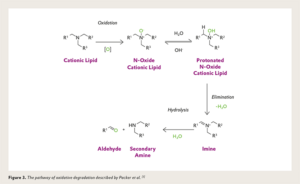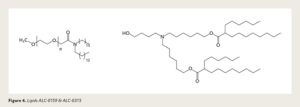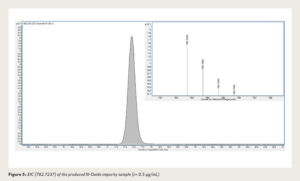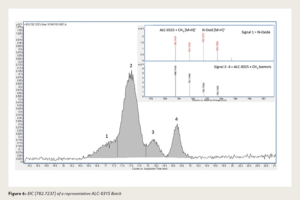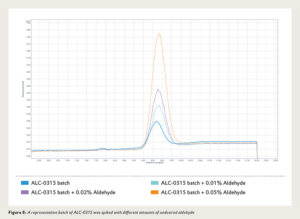WHITEPAPER - Purity is Paramount: Assessing N-Oxide Impurities in Lipids Used in Lipid Nanoparticle Delivery Systems

By: Sabrina Metze, PhD, Ulrich Klöckner, PhD, Lars Geiger, PhD, Justin Schieven, PhD, and Thomas Böhmer*
Summary
The quality of lipids in a lipid nanoparticle assembly is critically important to the functionality of mRNA-based therapeutics. Packer et al. have identified a key impurity in cationic lipids, N-Oxide, that is responsible for a loss in transcription and translation activity of the mRNA cargo.[5] This study demonstrates that Evonik is capable of manufacturing high-quality lipids with a purity greater than 99% and a consistently low level of the N-Oxide impurity.
Introduction
Lipid nanoparticles have become essential for the mRNA COVID-19 vaccines. In 2021, the COVID-19 mRNA-based vaccines developed by BioNTech/Pfizer and Moderna were the first FDA-approved vaccines, and spread hope for a way out of the pandemic.[1,2] Moreover, this novel drug delivery strategy paved the way for many future possibilities in the field of mRNA drug delivery. Scientists have been studying mRNA drug delivery systems for more than 20 years. The goal is for this disruptive future technology to help tackle pandemics and a wide range of other diseases such as hereditary disorders, cancer, metabolic disorders, and infectious diseases.[3,4]
In these vaccines, the active mRNA is encapsulated in lipid nanoparticles (LNPs), which consist of a specific lipid composition that allows the intracellular delivery of mRNA and its subsequent release to unfold the mode of action (Figure 1). The efficient encapsulation of the labile mRNA is crucial for the efficiency of the LNPs formed.
Problem Statement
Besides the significant role that lipids play in the formation of LNPs and in the actual drug delivery, their quality is crucial for the safety of patients. Any unwanted chemical reaction between the lipids and the labile mRNA will affect the product stability and efficacy of the vaccine or therapeutic. In a Nature Communications article from 2021, Packer et al. described the direct impact of lipid qualities on the LNP formation itself and vaccine effectiveness.[5] They reported the identification of an important class of impurities for ionizable cationic lipids, which ultimately results in a disruption in the mRNA translation. This can lead to a loss of protein expression and thereby have a negative impact on the activity of an LNP-formulated mRNA product. Commonly used ionizable cationic lipids are shown below in Figure 2.
Packer et al. describe the formation of a lipid-mRNA adduct derived from an impurity in cationic lipids which leads to loss in activity (Figure 3). According to their analysis, an N-Oxide impurity formed in cationic lipids is responsible for this effect because it can further hydrolyze to the respective aldehydes and free amine. Subsequently, the active aldehyde reacts with the mRNA, disrupts mRNA translation and thereby negatively impacts mRNA product activity. The formation of this N-Oxide impurity is problematic for this class of ionizable lipids and stringent manufacturing control is crucial.[5]
The pathway described above is not the only potential source of the undesired aldehyde. The aldehyde could also be present if used as an intermediate in the lipid manufacturing process. This further highlights the importance of a well-developed purification process able to consistently reduce quantities of this impurity to levels which eliminate any potential negative impact.
Analysis of Impurity Levels in ALC-0315 Produced by Evonik
Evonik’s life sciences division, Nutrition and Care, is a leading company offering lipids for lipid nanoparticle formulations and drug delivery applications. Since early 2021, Evonik has been supplying urgently needed lipids used in the production of the BioNTech/Pfizer COVID-19 vaccine, COMIRNATY®.[6]
Evonik manufactures ALC-0159 and ALC-0315. ALC-0159 is a PEGylated lipid, whereas ALC-0315 is an ionizable lipid (Figure 4).
Evonik offers high quality standards to provide safe and effective lipid products. The purity of Evonik ALC-0315 batches is typically above 99%. Within the quality control, the purity of ALC-0315 and the evaluation of by-products is monitored by High Performance Liquid Chromatography utilizing a Charged Aerosol Detector (HPLC-CAD).
N-Oxide Impurity Study
As mentioned above, one of the major critical impurities for ionizable lipids is the N-Oxide impurity. Packer et al. have proven that the control of this critical impurity is crucial to ensure quality of the cationic lipids and activity of the LNP product. Within the standard QC release procedure, the N-Oxide impurity in monitored down to a level of 1.0%.
Due to the high importance of the N-Oxide impurity, an analytical study was initiated to evaluate this impurity down to trace level concentrations.
First, a sample of this impurity was produced as a qualitative and quantitative reference material. For the analytical evaluation, High Performance Liquid Chromatography – Mass Spectrometry (HPLC-MS) was applied utilizing HPLC conditions of the standard product control procedure in combination with a high-resolution mass spectrometer (Agilent 6500 Series QTOF). The extracted ion chromatogram (EIC) of the standard material is shown in Figure 5.
For its detection in the ALC-0315 lipid, the HPLC-MS system was adjusted to 782.7237 ([M+H]+), the main isotope of the N-Oxide.
In the study, nine representative batches from different production campaigns completed in 2021 were investigated. The main challenge was that the ALC-0315+CH2, another well-known impurity in the lipid, could not be completely separated. Due to the isotopic pattern of the ALC-0315+CH2 (presence of isotope M+2 ≈ 14 %) an overlap of the main isotope of the N-Oxide was recorded (Figure 6).
The quantification was based on peak area; the corresponding peak area for the N-Oxide was determined by dropping a perpendicular line between the signals 1 and 2, representing the worst-case scenario for the amount of N-Oxide.
Representative chromatograms of the spiking experiment are shown in Figure 7.
To overcome the issue of the overlapping peaks, a standard addition evaluation was performed to estimate the amount of N-Oxide. Standard addition was performed to examine the amount of N-Oxide in the analyzed representative batches. A maximum amount of < 0.03% was detected, however the amount of the N-Oxide is likely to be overestimated due to the overlapping of the ALC-0315 +CH2 isomer.
Aldehyde Impurity Study
In a second study, the trace level concentration of the corresponding undesired aldehyde in the final product (ALC0315) was analyzed by HPLC-MS. For the detection of the corresponding aldehyde, the HPLC-MS system was adjusted to 377.3 ([M+Na]). Within the study, eight representative batches from different campaigns completed in 2021 were investigated.
To estimate the amount of the corresponding aldehyde, a standard addition evaluation with reference material was performed. The quantification was based on the corresponding peak area of the aldehyde.
Representative chromatograms from the spiking experiment for one batch are shown in Figure 8. The corresponding aldehyde was detected at only ppm levels in those experiments. In most cases the detected level was < 0.01%, while one case had a detected level of around 0.015%.
Conclusion
N-Oxide and corresponding aldehyde impurities present or formed in cationic lipids are responsible for a loss in protein expression of the mRNA cargo.[5] Therefore, it is essential to ensure strict manufacturing control and robust analytical methods to provide stability of the LNP formulation for efficient delivery and activity of the mRNA. This study demonstrates that Evonik is capable of manufacturing high-quality lipids with a purity greater than 99% and a consistently low level of the critical N-Oxide and aldehyde impurities. In all investigated batches from Evonik, the N-Oxide impurity was determined to be below 0.03% and the level of the undesired aldehyde was below 0.015%. These very low amounts of impurities in the lipids is negligible and is not expected to negatively influence the properties or performance of the LNP formulation.
To download a PDF of this whitepaper, click here.
Literature
[1] Polack, F. P. et al. Safety and efficacy of the BNT162b2 mRNA Covid-19 vaccine. N. Engl. J. Med 383, 2603–2615 (2020).
[2] Baden, L. R. et al. Efficacy and safety of the mRNA-1273 SARS-CoV-2 vaccine. N. Engl. J. Med 384, 403–416 (2021).
[3] Gómez-Aguado, I. et al. Nanomedicines to deliver mRNA: state of the art and future perspectives. Nanomaterials 10, 364 (2020).
[4] Ann J. Barbier et. al. The clinical progress of mRNA vaccines and immunotherapies. Nature Biotechnology 40, 840-854, (2022).
[5] M. Packer, D. Gyawali, R. Yerabolu, J. Schariter, P. White; Nature Communications; 12, 1-11, (2021).
[6] Evonik April 22, 2021 https://corporate.evonik.com/en/start-of-production-in-record-time-evonik-delivers-first-lipids-from-german-facility-to-biontech-157106.html.
* Sabrina Metze, PhD, Head of QC Operations, Evonik Health Care
Ulrich Klöckner, PhD, Global Project Manager, Evonik Health Care
Lars Geiger, PhD, Global Director Project Management Drug Substance, Evonik Health Care
Justin Schieven, PhD, Head of Laboratory for Liquid Chromatography, Analytical Laboratory Essen, Evonik
Thomas Böhmer, Head of Chromatography & Mass Spectroscopy, Analytical Laboratory Essen, Evonik
Total Page Views: 6483





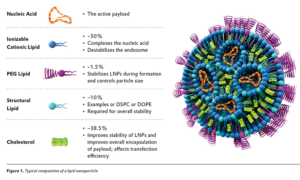
![Figure 2. Ionizable lipids used in mRNA therapies [4]](https://drug-dev.com/wp-content/uploads/2023/03/Figure-2-Ionizable-lipids-used-in-mRNA-therapies-1-300x170.png)
